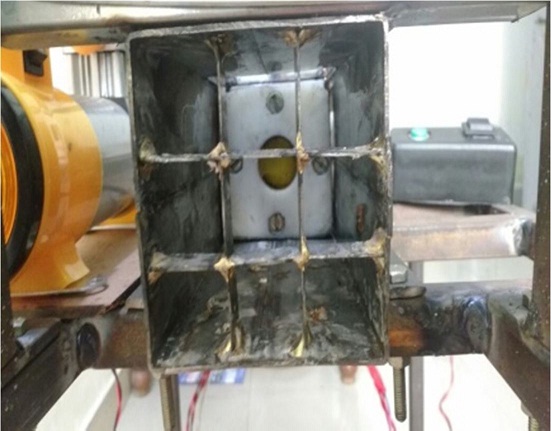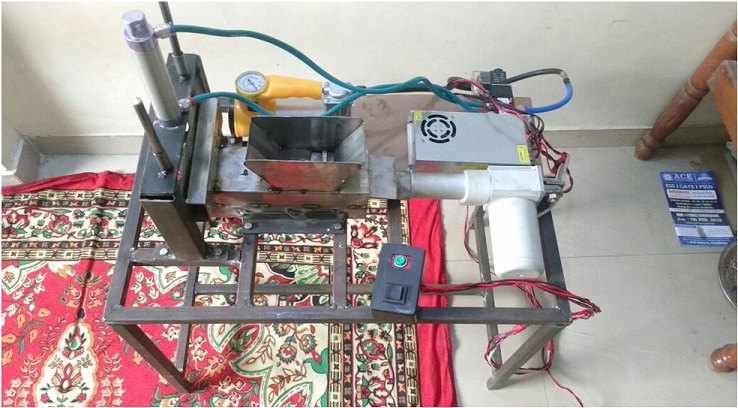





Published on Nov 30, 2023
Mangos are used for making mango juice, mango pickle and etc., for making mango pickle, have to cut the mangos into cubic pieces. And the mangos are cut by manual cutting system, by hand and knife. Manual cutting system is not safe because it lead to injuries like cutting workers hand and fingers and also difficult to cut the mango because of presence of its hard seed.
In the present work it is planned to design and fabricate the mango cutting machine which overcome the drawbacks of the previously existing machines. To cut the mangos into cubic pieces, the blades are fixed to the inner wall of the cover and to the rotating shafts. The rotating shafts are mounted with the three covers one upon the other in which the 2nd shaft is perpendicular to the 1st and 3rd shaft by using bearings. The power from the motor to the 1st shaft is transmitted by using pulleys and belt drive. To obtain the required speed of the shaft different diameter of pulleys are mounted in the motor and in the shaft. The power from the 1st shaft to the 2nd and 3rd shaft is transmitted by using pulleys and belt drive.
Mango (Mangifera indica L) is one of the most important fruit worldwide and is cultivated in more than 100 countries at both tropical and subtropical latitudes, especially in Asia. India is a leading mango growing country and produces about 65 % of the world’s total mango produced. It is considered as the most important fruit covering 35 % of area and 28 % of total production of fruits in the country. In India the area under mango cultivation was about 2500 thousand ha and about 18002.4 thousand metric tons of mango were produced during the year 2012-13. The Gujarat contributed 5.6 per cent on mango cultivation (Anon, 2013).
In Gujarat state, the area under mango cultivation was about 141258 ha and about 1003706 metric tons of mango were produced during the year 2012-13 (Anon, 2013). The district wise area and production of mango in Gujarat during the year 2012-13 is given in Table 1.2. The major contributing districts of Gujarat are Valsad, Junagadh, Navsari, Surat, and Amreli (Anon, 2013). Mango is one of the most cherished fruits, not only in flavor and taste, but also for its nutritional value. Malik et al., (1994) reported that mango is a good source of vitamin A and C and rich in carbohydrates, minerals potassium, and phosphorus.
Ripe mango is mainly consumed as fresh fruit but due to its perishable nature it cannot be stored for long duration and consequently, substantial quantity of the crop is annually lost. Therefore, Mango is being processed into many products that include mango juice, mango nectar, squash, mango concentrates and jam (Husain et al.,2005). Handling of mango is done manually and in unhygienic ways. Most of the raw mango pickle industries in Gujarat perform basic operations like peeling, cutting, slicing, grating, and dicing. All these operations are tedious and labor intensive, as it involves manual work.
So it is essential to mechanize these operations by developing efficient machines which can reduce the processing time as well as cost of operation and make the process more hygienic. Mechanical operation of slicing and cube cutting of raw mango is advantageous as it involves more precise slicing and cube cutting than the manual cutting. It reduces fruit damage and improves the efficiency and accuracy. However, only limited work has been done and published on the development of slicing and cube cutting machines. Therefore, the present study was undertaken with specific objectives to develop an appropriate, efficient raw mango slicer and cube cutter for mechanizing the pickle processing industry
To design and fabricate mango cutting machine is to cut the mangos into cubic pieces, which should be used for making mango pickles.
To converting manual cutting system into automated cutting system.
To increase the productivity.
To overcome the time consumption. Because in other existing mango cutting machines, they are carrying the mango pieces form one machine to another machine to do different operations like first cutting the mangos into two pieces and then cutting those pieces into cubic pieces.
To reduce the labors uncertainty.
In this mango cutting machine, the raw mangos are poured in the hopper. Where the hopper is a funnel shaped section at the top of the setup to collect raw mangos, the hopper is used in this machine for moving the mangos into the 1st cover.
The main switch is turned on and the power is supplied to the 3 phase motor. This transmits power to the 1st cover shaft. And by the help of 1st cover shaft the power is transmitted to the 2nd and 3rd cover shafts to cut the mangos into pieces in different stages.
In the 1st cover the mangos comes from hopper and mangos falls on the movable blades. Mangos moves with the blades mounted in the shaft, which rotates towards the fixed blades. The mango stuck between moving blade and fixed blade. And because of shear force between the blades and mango, the mango will cut into round pieces. And simultaneously those round mango pieces moves to the 2nd cover.
In the 2nd cover, the round cut mango pieces comes from the 1st cover and falls on the 2nd cover moving blades. And those round cut mango pieces moves with blades in the rotating shaft towards the fixed blades. The rotating shaft of 2nd cover which is mounted perpendicular to the 1st cover shaft. And those round cut mango pieces stuck between the moving blades and fixed blades. Because of shear force between the blades and the round cut mango pieces, the round cut mango pieces cuts into slice. And then simultaneously those mangos slice moves to the 3rd cover. The slice cuts as shown in the below figure.
And in the 3rd cover, the mango slices comes from the 2nd cover and falls on the moving blades. And those mangos slice moves with the blades in the rotating shaft towards the fixed blades. The shaft of 3rd cover is mounted perpendicular to the 2nd cover shaft and parallel to the 1st cover shaft. And those mango slices stuck between the moving blades and fixed blades. Because of shear force between the mango slices and blades, the mango slices cuts into cubic pieces.
single phase ac motor, blades, shaft, plummer blocks, pulleys, belts, angles, nuts and bolts.
Made by M.S. Sheet of 155mm*75mm for easy discharge.
The cutting blades are fixed which are made from hardened stainless steel with sharp 1mm cutting edge, 80mm length & 80mm width. Thickness of the blade was 3mm to bear the cutting pressure of mango slices.
The collecting unit used to collect cubes discharged from inclined hopper provided below the cutting unit.
Height & width are decided based on the length of mango slide. Frame provides the strength to the cube cutter.

It is a device which here is providing linear forward and backward motion to the mangoes. It is being operated on 12V DC supply.
It is device which converts low pressure air into high pressure air. It pressurize the air. There are two types of air compression, generally used. It may be divided into either positive or negative displacement compressors.
It is device in which piston can have its movement by the application of air. It can have reciprocating linear motion.
It is used here, to control the flow of air. The valve is operated by an electric current through solenoid. It is 5/2 DC flow control valve.

A. First of all we will put mango through hopper.
B. Then we will press forward button on remote.
C. Then actuator will provide forward motion to inserted mango.
D. The mango will reach near 9 box cube shaped die.
E. Then we will press hit button on remote control.
F. The piston which was in initially at top position is driven down by pneumatic force obtained by compressor.
G. The piston is having vertical blade attached to it.
H. The motion of vertical blade cuts the mango into cube shape pieces.
1. After processing of all three stages of mango cutting operations, the final outcome from the last stage process by this machine is small mango pieces.
2. This machine cuts 360kg of mangoes per hour.

This mango cutting machine can install in small scale mango pickle industry for mass production of mango pickles.
In rural houses were pickles are produced in home.
And also can install in hotels for doing pickles.
And also can be cut vegetables and fruits other than mangoes.
1. In the present work the mango cutting mechanism is designed and developed.
2. The mango cutting operation is carried out in three different stages.
3. In the first stage, the raw mangoes are cut into round slices.
4. In the second stage, the round slices from first stage are cut into long rectangular slices.
5. Then in the third stage, the long rectangular slices from second stage are cut into cubic shapes.
6. By reducing distance between blades and making correct alignment of blades, the cubic shape mango pieces can be produced.
[1] Abdel Rahman, M. M. (1999). Handling engineering of some vegetables and fruit.
[2] crops. Unpublished Ph. D. Thesis, Agric. Mech. Dept., Agric. Fact. Mansoura
[3] Hussain, I.; Sabeen, N. G.; Muhammed, R. K.; Khan, T. M. (2004).
[4] Bundit et al. (2009). Developed, tested and evaluated a prototype automatic young